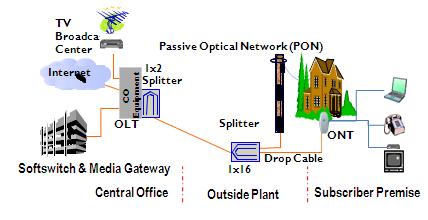- Fiber Optic Transceiver Module
- High Speed Cable
- Fiber Optical Cable
- Fiber Optical Patch Cords
- Splitter CWDM DWDM
- PON Solution
- FTTH Box ODF Closure
- PCI-E Network Card
- Network Cables
- Fiber Optical Adapter
- Fiber Optical Attenuator
- Fiber Media Converter
- PDH Multiplexers
- Protocol Converter
- Digital Video Multiplexer
- Fiber Optical Tools
- Compatible
- Data Center Solutions
- Top 5 features of xPON OLTs ...
- SFP-10G-SR and SFP-10G-LR �...
- Fused Biconic Tapered Splitt...
- What is TDMOIP
- The direct difference betwee...
- Nondispersion-Shifted Fiber(...
- About OM3 fiber
- What is an optical fiber
- The feature of Multi-mode op...
- HBA card
- About HBA
- Fiber closure
- Active Fiber Optic Cable Con...
- What are the types of fiber ...
- Sopto SC and FC Fiber Fast C...
- Outdoor FTTH Cabinet
- CWDM multiplexer
- DWDM multiplexer
- What is the advantages of di...

The advantages and disadvantages of PON technology
A passive optical network (PON) does not include electrically powered switching equipment and instead uses optical splitters to separate and collect optical signals as they move through the network. A PON shares fiber optic strands for portions of the network. Powered equipment is required only at the source and receiving ends of the signal. Passive optical networks, or PON, have their special advantages. They're efficient, in that each fiber optic strand can serve up to 32 users. PON has a low building cost relative to active optical networks along with lower maintenance costs. Because there are few moving or electrical parts, there's simply less that can go wrong in a PON.
A PON takes advantage of wavelength division multiplexing (WDM), using one wavelength for downstream traffic and another for upstream traffic on a single mode fiber (ITU-T G.652). BPON, EPON, GEPON, and GPON have the same basic wavelength plan and use the 1,490 nanometer (nm) wavelength for downstream traffic and 1,310 nm wavelength for upstream traffic. 1,550 nm is reserved for optional overlay services, typically RF (analog) video.
As with bit rate, the standards describe several optical budgets, most common is 28 dB of loss budget for both BPON and GPON, but products have been announced using less expensive optics as well. 28 dB corresponds to about 20 km with a 32-way split. Forward error correction (FEC) may provide another 2–3 dB of loss budget on GPON systems. As optics improve, the 28 dB budget will likely increase. Although both the GPON and EPON protocols permit large split ratios (up to 128 subscribers for GPON, up to 32,768 for EPON), in practice most PONs are deployed with a split ratio of 1x32 or smaller.

A PON consists of a central office node, called an optical line terminal (OLT), one or more user nodes, called optical network units (ONUs) or optical network terminals (ONTs), and the fibers and splitters between them, called the optical distribution network (ODN). “ONT” is an ITU-T term to describe a single-tenant ONU. In multiple-tenant units, the ONU may be bridged to a customer premises device within the individual dwelling unit using technologies such as Ethernet over twisted pair, G.hn (a high-speed ITU-T standard that can operate over any existing home wiring - power lines, phone lines and coaxial cables) or DSL. An ONU is a device that terminates the PON and presents customer service interfaces to the user. Some ONUs implement a separate subscriber unit to provide services such as telephony, Ethernet data, or video.
An OLT provides the interface between a PON and a service provider′s core network. These typically include:
IP traffic over Fast Ethernet, gigabit Ethernet, or 10 Gigabit Ethernet;
Standard TDM interfaces such as SDH/SONET;
ATM UNI at 155–622 Mbit/s.
The ONT or ONU terminates the PON and presents the native service interfaces to the user. These services can include voice (plain old telephone service (POTS) or voice over IP (VoIP)), data (typically Ethernet or V.35), video, and/ortelemetry (TTL, ECL, RS530, etc.) Often the ONU functions are separated into two parts:
The ONU, which terminates the PON and presents a converged interface—such as DSL, coaxial cable, or multiservice Ethernet—toward the user;
Network termination equipment (NTE), which inputs the converged interface and outputs native service interfaces to the user, such as Ethernet and POTS.
A PON is a shared network, in that the OLT sends a single stream of downstream traffic that is seen by all ONUs. Each ONU only reads the content of those packets that are addressed to it. Encryption is used to prevent eavesdropping on downstream traffic.
Of course, PON also has disadvantages. They have less range than an active optical network, meaning subscribers must be geographically closer to the central source of the data. PON also make it difficult to isolate a failure when they occur. On the other hand, because the bandwidth in a PON is not dedicated to individual subscribers, data transmission speed may slow down during peak usage times in an effect known as latency. Latency quickly degrades services such as audio and video, which need a smooth rate to maintain quality. If you need more info., please send your requirements to info@sopto.com


